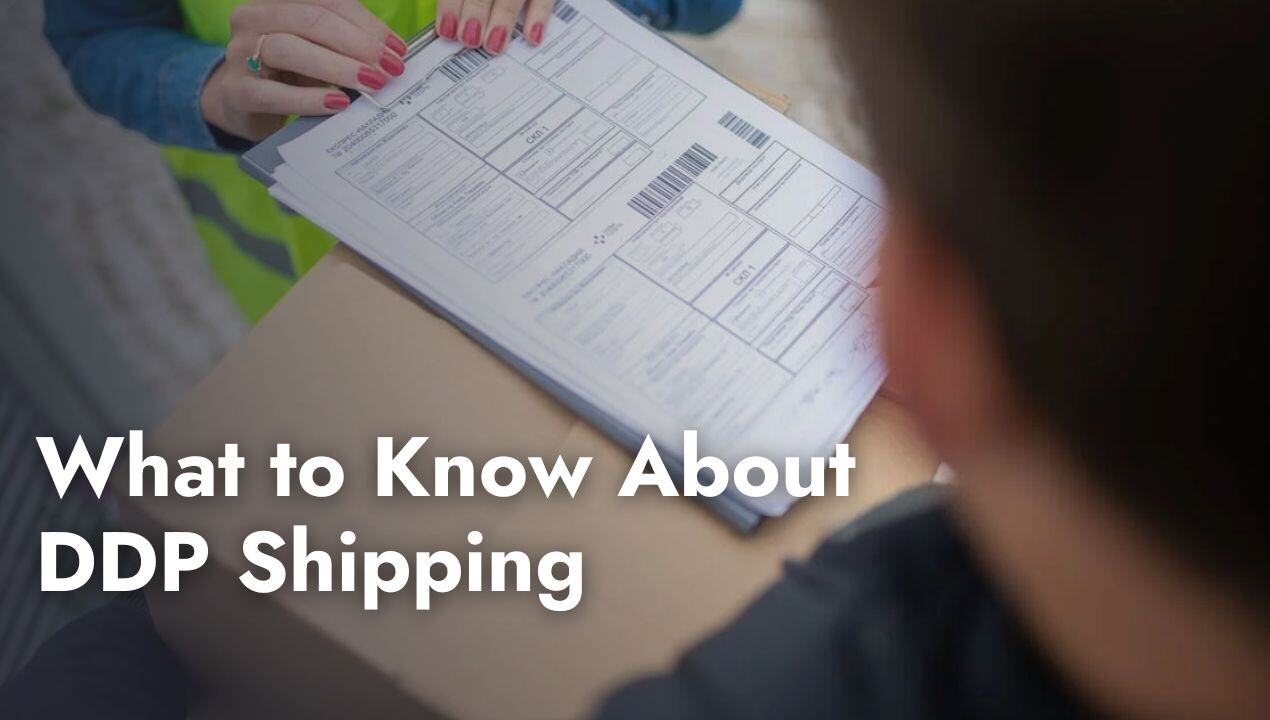Share this
What to Know About DDP Shipping In 2024
by Rin Mosher on May. 30, 2024

Delivered Duty Paid (DDP) shipping is a popular choice among ecommerce businesses that sell and ship goods internationally. Its benefits are plentiful, ranging from improved conversion rates to higher levels of customer satisfaction and loyalty. But DDP in shipping must be done right in order to offer these positive outcomes.
In this article, we explore how DDP fulfillment works, the costs it involves, and when it can be beneficial for your ecommerce business.
What Is DDP Shipping?
DDP shipping, short for Delivered Duty Paid shipping, is a type of international shipping agreement where the seller assumes all the risks and costs associated with transporting goods until they are received by the buyer. This includes paying for shipping costs, export and import duties, insurance, and any other shipping expenses.
DDP shipping is advantageous for ecommerce buyers as the price they’re presented with at checkout is all-inclusive of any fees, taxes, or duties. They won’t have to worry about having to pay extra import duties in order to accept their package.
How DDP Shipping Compares to Other Shipping Methods
DDP shipping is regulated by the International Chamber of Commerce’s Incoterms (International Commercial Terms) – a set of industry-recognized rules that define buyers’ and sellers’ responsibilities in global business trade. Other types of arrangements exist as well, with the most popular alternative to DDP being delivered at place (DAP) shipping.
The biggest difference between DDP and DAP is who pays for duties and taxes. With DAP shipping, ecommerce sellers leave these costs for consumers to pay, while with DDP, the seller pays applicable fees and taxes on their behalf. This creates convenience for consumers who would otherwise need to absorb costs themselves. It’s not always at the business’ expense, however. Many ecommerce companies compensate for the costs of DDP shipping with higher product prices and checkout fees.
Responsibility and liability are two other key differentiators. DAP sees sellers deliver packages to an agreed-upon location within the receiving country, but their responsibility does not include customs clearance or payment of duties and taxes. With DDP, however, the seller is responsible for clearing packages through customs and remains responsible for it until it’s delivered. DAP essentially offloads the risk of having to resolve issues with domestic transport onto the buyer.
Benefits of DDP Shipping for Ecommerce Businesses
DDP isn’t always painted as advantageous for ecommerce sellers. How could a business benefit from assuming more liability and cost? There are a number of ways, which, depending on the priorities of your business, may make DDP shipping worthwhile.
Simplifies International Orders
DDP arrangements simplify international shipping by limiting the number of points of contact involved. The seller coordinates customs clearance and delivery, so buyers don’t need to do anything but wait for their package to arrive. This mitigates confusion, minimizes back-and-forth exchanges, and ensures that the goods arrive faster and with fewer hiccups along the way.
Boosts Conversion Rates
International customers may come to the table with more hesitancy to purchase if they aren’t clear on how duties will be handled post-transaction. Confirming that these extra charges won't have to be paid upon delivery during the checkout process can give international customers an extra push of confidence, reducing cart abandonment and improving conversion rates.
Improves Customer Experience
There’s a reason why companies like Amazon and eBay use DDP shipping, and that’s because it keeps customer satisfaction high. Prioritizing the customer experience by using DDP shipping to ensure all costs are included upfront leaves a lasting positive impression on consumers while building a reputation for reliability and transparency. In that sense, the upfront costs of DDP ecommerce shipping can be thought of as an investment in customer satisfaction.
If you’re not transparent with your customers about your shipping method, the added duties and taxes may come as an unwanted surprise. If the buyer is caught off guard and refuses to pay the extra fees, their order will ultimately be sent back to you at an added expense – plus, you’ll be hit with a chargeback.
Gives a Competitive Advantage
Offering DDP shipping can differentiate a business from its competitors by positioning it as a customer-centric option in the market. When customers know they can count on your business for timely and surprise-free delivery, they’ll feel more comfortable choosing it first when shopping online in the future. And for new customers deciding between a business that offers upfront and all-inclusive pricing and one that doesn’t, the choice can be straightforward, potentially leading to increased sales and market share.
Also, remember that choosing DDP shipping doesn’t mean having to pay for import costs on your own. Calculating the total landed cost of individual products and incorporating that into your pricing strategy can help offset the costs of DDP shipping.
How Much Does DDP Shipping Cost?
Total DDP shipping cost is the culmination of several fees and expenses added onto a package’s journey from one country to another. When you choose this arrangement, you’re agreeing to pay them all upfront. These costs vary depending on the type of product being shipped, its value, the volume of goods, and the destination. Each country imposes its own set of fees, duties, and taxes, according to its specific regulations and laws. Here’s a general overview of the most common costs incurred when shipping internationally:
Value-Added Tax (VAT)
Many countries impose a value-added tax (VAT) on internationally shipped goods. It is assessed based on the type of item and typically ranges between 5% and 20%. In a DDP agreement, the seller is responsible for paying the VAT upfront.
Insurance
Many businesses invest in third-party insurance policies to insulate themselves from the risks of shipping internationally using the DDP model. If anything were to happen to the shipment, such as damage or loss, the insurance would cover any associated costs. This is particularly important for high-value items or products that are easily damaged during transit.
Customs Duties
Most international shipments are subject to customs duties, which are calculated based on the item type, value, and the policies of the destination country. Under DDP terms, the seller pays these duties, which can include tariffs, processing fees, and additional taxes.
Import Clearance Fees
Brokers or freight forwarders typically charge fees to clear shipments through customs. These fees vary depending on the type of goods and can be affected by additional documents needed to complete customs clearance.
Inspections, Certifications, and Permits
Some goods require inspections, special certifications, or import permits to clear customs. Under DDP terms, the seller is responsible for any associated fees, which add to their total shipping expenses.
How to Know If DDP Shipping Is Right for You
Whether DDP shipping is right for your ecommerce business comes down to the sensibility of its cost. Assuming expenses on customers’ behalf can have positive effects on their perception of your brand and increase the likelihood of them making future purchases.
However, today’s online shoppers are accustomed to free shipping and might not appreciate the absence of duty and customs fees. Yet not paying these expenses by shipping DAP isn’t likely to go unnoticed. It’s a matter of weighing the pros and cons of each option against your business’ needs. If the costs of DDP are too high to justify, be sure to communicate customers’ liability for import expenses during the online checkout process.
Deciding whether DDP shipping is the right choice for your ecommerce business comes down to the sensibility and benefits of its cost. Covering expenses such as duties and customs fees on behalf of customers can enhance their perception of your brand and may increase their likelihood of repeat purchases. However, many online shoppers today expect free shipping and might not recognize the added value of prepaid duty and customs fees.
Conversely, opting for DAP shipping, where customers are responsible for these fees, will likely be noticed and could affect their shopping experience. It's important to weigh the pros and cons of each shipping method according to your business needs. If the costs of DDP are prohibitively high, be sure to clearly communicate any potential import expenses to customers during the checkout process.
Need a 3PL Provider?
DDP shipping offers great benefits, but those benefits are only realized with a smart implementation process. You can make the most out of DDP in shipping by working with a qualified third-party logistics (3PL) company like Shipfusion.
Our ecommerce fulfillment experts will guide the planning process to ensure every DDP shipment your business sends is worthwhile. We can also help improve the affordability of your domestic shipments by up to 37% by negotiating exclusive rates with the country’s biggest carriers.
Share this
You May Also Like
These Related Articles

What is Dunnage in Shipping? Using it to Improve Shipping Efficiency and Costs

Flat Rate Shipping vs. Free Shipping: Key Differences To Keep In Mind

How to Calculate Flat Rate Shipping for a Winning Strategy for Your Ecommerce Business
- April 2025 (18)
- March 2025 (26)
- February 2025 (26)
- January 2025 (37)
- December 2024 (16)
- November 2024 (23)
- October 2024 (22)
- September 2024 (27)
- August 2024 (9)
- July 2024 (8)
- June 2024 (5)
- May 2024 (8)
- April 2024 (8)
- March 2024 (6)
- February 2024 (6)
- January 2024 (5)
- December 2023 (3)
- November 2023 (3)
- October 2023 (5)
- September 2023 (4)
- August 2023 (2)
- July 2023 (1)
- June 2023 (4)
- March 2023 (2)
- October 2022 (1)
- September 2022 (5)
- August 2022 (4)
- July 2022 (7)
- June 2022 (4)
- May 2022 (4)
- April 2022 (6)
- March 2022 (2)
- February 2022 (1)
- January 2022 (3)
- December 2021 (2)
- November 2021 (4)
- October 2021 (2)
- September 2021 (5)
- August 2021 (4)
- July 2021 (4)
- June 2021 (3)
- May 2021 (2)
- April 2021 (3)
- March 2021 (3)
- February 2021 (3)
- January 2021 (2)
- December 2020 (4)
- November 2020 (2)
- October 2020 (4)
- September 2020 (2)
- July 2020 (5)
- June 2020 (4)
- May 2020 (2)
- April 2020 (2)
- March 2020 (4)
- February 2020 (1)
- December 2019 (1)
- May 2018 (1)
- March 2018 (2)
- February 2018 (3)
- January 2018 (3)
- November 2017 (3)
- July 2017 (4)
- March 2017 (3)
- February 2017 (5)
- January 2017 (3)
- December 2016 (4)
- November 2016 (6)
- October 2016 (6)
- October 2015 (1)
- September 2015 (1)
- June 2015 (3)
- May 2015 (3)
- August 2014 (1)
- July 2014 (1)
- March 2014 (1)
- February 2014 (1)